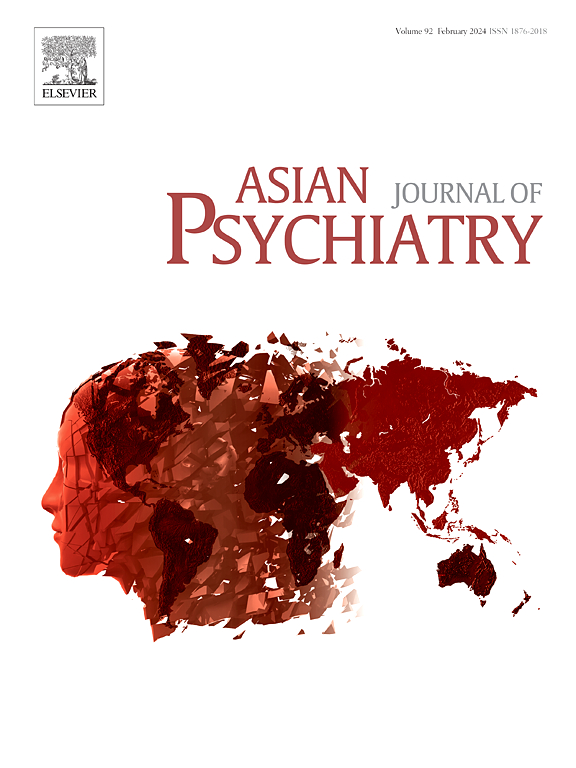Urban built density and brain connectivity predict antipsychotic response in a sex-specific manner in Schizophrenia
IF 4.5
4区 医学
Q1 PSYCHIATRY
引用次数: 0
Abstract
Background
Urbanicity is a well-established environmental risk factor for schizophrenia, particularly in males, yet it is also associated with better antipsychotic treatment response. We aimed to identify resting-state functional connectivity (rsFC) correlates of neighborhood geospatial features in a hypothesis-free, whole-brain analysis of individuals with first-episode schizophrenia (FES). We further examined whether these geospatial variables and their rsFC correlates interact with sex to predict response to oral risperidone over six weeks.
Methods
We studied 48 antipsychotic-naïve individuals with FES residing in or around Bangalore, India. Whole-brain within-network connectivity analyses were conducted to identify rsFC correlates of neighborhood built-density and green space. We tested whether sex moderated the relationship between geospatial variables (or their rsFC correlates) and treatment response using a moderation analysis framework implemented through structural equation modelling.
Results
Higher built density was associated with increased connectivity in the superior occipital and default mode networks, and decreased connectivity in the basal ganglia–thalamic network. While built density and rsFC measures were not significantly associated with treatment response in the overall sample, sex-specific disordinal interactions were observed: in males, higher built density and associated rsFC predicted greater symptom improvement; in females, the same features predicted poorer treatment response.
Conclusions
In FES, built density and its rsFC correlates are associated with treatment response in opposite directions, depending on sex – beneficial in males and detrimental in females – supporting a differential susceptibility model. These findings highlight the importance of incorporating neurourbanism and sex-specific approaches into personalized psychiatric care.
城市建筑密度和大脑连通性以性别特异性的方式预测精神分裂症的抗精神病药物反应
背景:都市化是一个公认的精神分裂症的环境风险因素,尤其是在男性中,但它也与更好的抗精神病治疗反应有关。我们旨在通过对首发精神分裂症(FES)患者进行无假设的全脑分析,确定静息状态功能连接(rsFC)与邻域地理空间特征的相关性。我们进一步研究了这些地理空间变量及其rsFC相关性是否与性别相互作用,以预测口服利培酮6周后的反应。方法对居住在印度班加罗尔及周边地区的48例antipsychotic-naïve FES患者进行研究。进行全脑网络内连通性分析,以确定邻里建筑密度和绿地的rsFC相关性。我们测试了性别是否调节了地理空间变量(或其rsFC相关变量)与治疗反应之间的关系,使用了通过结构方程建模实现的调节分析框架。结果较高的构建密度与枕上网络和默认模式网络的连通性增加有关,与基底神经节-丘脑网络的连通性降低有关。虽然在整个样本中,体型密度和rsFC测量与治疗反应没有显著相关,但观察到性别特异性的异常相互作用:在男性中,体型密度和相关的rsFC预示着更大的症状改善;在女性中,同样的特征预示着较差的治疗反应。结论在FES中,构建密度及其rsFC相关因子与治疗反应呈相反方向相关,取决于性别——对男性有利,对女性不利——支持差异易感性模型。这些发现强调了将神经城市化和性别特异性方法纳入个性化精神病学护理的重要性。
本文章由计算机程序翻译,如有差异,请以英文原文为准。
求助全文
约1分钟内获得全文
求助全文
来源期刊

Asian journal of psychiatry
Medicine-Psychiatry and Mental Health
CiteScore
12.70
自引率
5.30%
发文量
297
审稿时长
35 days
期刊介绍:
The Asian Journal of Psychiatry serves as a comprehensive resource for psychiatrists, mental health clinicians, neurologists, physicians, mental health students, and policymakers. Its goal is to facilitate the exchange of research findings and clinical practices between Asia and the global community. The journal focuses on psychiatric research relevant to Asia, covering preclinical, clinical, service system, and policy development topics. It also highlights the socio-cultural diversity of the region in relation to mental health.
 求助内容:
求助内容: 应助结果提醒方式:
应助结果提醒方式:


